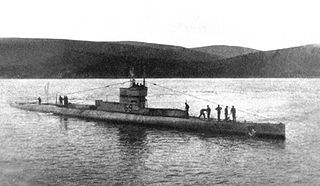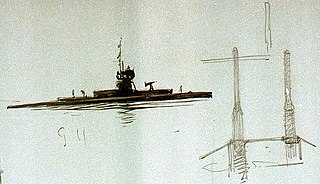
The Royal Navy's G-class of diesel-electric submarines were launched between 1914 and 1917, and intended for operations in the North Sea and German Bight in World War I against German U-boats.
HMS D3 was a D-class submarine of the British Royal Navy, one of eight of this class. D3 was built by Vickers at their Barrow-in-Furness works in 1910–1911, being launched on 17 October 1910 and completed on 30 August 1911.
HMS D5 was one of eight D-class submarines built for the Royal Navy during the first decade of the 20th century.

HMS E5 was a British E-class submarine built by Vickers Barrow-in-Furness. She was laid down on 9 June 1911 and was commissioned on 28 June 1913. She cost £106,700. E5 was sunk, probably by striking a mine, on 7 March 1916.

HMS C10 was one of 38 C-class submarines built for the Royal Navy in the first decade of the 20th century. The boat survived the First World War and was sold for scrap in 1922.
HMS L7 was a L-class submarine built for the Royal Navy during World War I. The boat survived the war and was sold for scrap in 1930.

HMS L9 was an L-class submarine built for the Royal Navy during World War I. The boat survived the war and was sold for scrap in 1927.

HMS E30 was a British E-class submarine built by Armstrong Whitworth, Newcastle upon Tyne. She was laid down on 29 June 1914 and was commissioned in November 1915. HMS E30 was lost in the North Sea, thought to have been mined off Orfordness, Suffolk on 22 November 1916, the minefield was not discovered until 25 November. There were no survivors.
HMS E32 was a British E-class submarine built by J. Samuel White, Cowes, Isle of Wight. She was launched on 16 August 1916 and commissioned in October 1916. HMS E32 was sold in Sunderland on 6 September 1922.

HMS B6 was one of 11 B-class submarines built for the Royal Navy in the first decade of the 20th century. The boat survived the First World War and was sold for scrap in 1921.

HMS G1 was a British G-class submarine built for the Royal Navy during World War I.

HMS G2 was a British G-class submarine built for the Royal Navy during World War I.

HMS G5 was a British G-class submarine built for the Royal Navy during World War I.

HMS G6 was a British G-class submarine built for the Royal Navy during World War I.

HMS G7 was a British G-class submarine built for the Royal Navy during World War I.

HMS G10 was a British G-class submarine built for the Royal Navy during World War I.

HMS G11 was a G-class submarine of the Royal Navy in service during the First World War. One of six of her class built by Vickers at Barrow in Furness, she was launched on 22 February 1916, and commissioned on 13 May 1916.

HMS G12 was a British G-class submarine built for the Royal Navy during World War I.

HMS G13 was a British G-class submarine built for the Royal Navy during World War I.

HMS G14 was a British G-class submarine built for the Royal Navy during World War I.








